Home / Guides / Citation Guides / APA Format / Paraphrasing in APA

Paraphrasing in APA
Paraphrasing is the art of putting information into your own words while writing a research paper, in order to maintain the academic integrity of your project. This is important because you need to use solid evidence as a researcher, but you need to put information into the proper format to avoid plagiarism. The American Psychological Association (APA) created a writing style in 1929 that calls for uniformity and consistency in giving credit to sources in your research.
How to properly paraphrase
If you do not properly paraphrase your source material following the APA style, you are at the risk of losing credibility as a writer and possibly plagiarizing. Although paraphrasing is not difficult, it does take time and a little forethought to do it correctly. There are several steps you should follow in order to achieve success.
1. Read the original source
The first step in creating an effective paraphrase is to carefully read the original source. Read it the first time to get the overall understanding, and then do a second closer reading in order to gather details and material that will help you formulate your argument.
2. Take notes in your own words
After reading the original source and determining what details can help you formulate your argument, take a minute to jot down some notes. Be careful to put everything into your own words. Change the structure of the sentence as well as the vocabulary.
Also, take a moment to take notes on the context of the source. Why was it written? Who wrote it? When was it written?
3. Construct a paraphrase
In order to construct a paraphrase, you need to include the same information, but with different sentence structure and different vocabulary. APA rules say that a paraphrase should be approximately the same length as the original.
You also need to add contextual text around the paraphrase so it fits within your paper.
4. Double check the original source to avoid duplication
Although an extra step, it is always a good idea to read through the original source one more time to make sure that you have chosen different words and varied the sentence structure. This is a good time to add the APA requirements of author and year of the source so that you have it handy.
5. Include an APA in-text citation
Even though you are putting a paraphrase into your own words, APA requires an in-text citation for paraphrasing. You can create a parenthetical citation or a narrative citation to accomplish this.
Remember: All in-text citations will also need a corresponding APA reference in the APA reference page . For this article, we’re just focusing on in-text citations in paraphrases.
For both types of in-text citation, you will need the following source information:
- Author’s last name
- Year published
- single page: p. #
- page range: pp. #-#
Parenthetical citation
For an APA parenthetical citation , write your paraphrase and then add the author and year in parenthesis at the end. Use a comma between the author and the year inside the parenthesis, and put the period for the end of the sentence outside the parenthesis.
Oh, say can you see by the dawn’s early light What so proudly we hailed at the twilight’s last gleaming? (Key, 1814).
My parents traveled from Italy to Germany and then France. As the oldest child, I traveled with them after being born in Naples. They were very close, and shared that love they had for each other with me (Shelley, 1818, p. 78).
Narrative citation
In a narrative citation, you introduce the author’s name as part of the sentence, and put the year in parenthesis.
Francis Scott Key (1814) wrote very special words while overlooking a battle: Oh, say can you see by the dawn’s early light, what so proudly we hailed at the twilight’s last gleaming?
For further details, visit this guide on APA in-text citations.
Paraphrasing example
Franklin Delano Roosevelt gave an inaugural address in January 1933 during the Great Depression. This is an excerpt taken from an online source :
This is preeminently the time to speak the truth, the whole truth, frankly and boldly. Nor need we shrink from honestly facing conditions in our country today. This great Nation will endure as it has endured, will revive and will prosper….
1. Read original source text
In order to paraphrase, read through the text once to get the gist of it, and then again for deeper understanding. The context of this passage is also significant. It was given by a U.S. president during the Great Depression. What do you think he was trying to achieve?
Next take notes in your own words. Without immediately looking at the text, jot down what you think is the main point or concept of it. Next, take notes on the context of the source (you can look at the source for this).
For this passage, a few example notes could be:
- Facing truth
- Harsh current reality
- Believing that this great nation will endure and eventually prosper again
- Speech by President Roosevelt in 1933
- Given during the Great Depression
- He was addressing his citizens
Now’s the time to construct the paraphrase. Based on the notes above, a paraphrase would look something like this:
With his inaugural speech, Roosevelt was carefully trying to prepare citizens of the Nation to face the harsh reality that the Great Depression had caused, while also reassuring them that the country would endure and eventually prosper again.
4. Double check with the original source
The paraphrase above doesn’t not look too similar to the original, but we could still change a few words that were also in the original phrase (like “Nation,” “endure,” and “prosper). Revised, it looks like this:
With his inaugural speech, Roosevelt was carefully trying to prepare citizens of the United States to face the harsh reality that the Great Depression had caused, while also reassuring them that the country would eventually bounce back .
5. Add an APA in-text citation
An APA in-text citation means including the source’s author, year published, and page numbers (if available). The paraphrase already has the author’s name, but the year published needs to be added in parentheses. This is from an online source so no page number is needed.
With his inaugural speech, Roosevelt (1933) was carefully trying to prepare citizens of the United States to face the harsh reality that the Great Depression had caused, while also reassuring them that the country would eventually bounce back.
Examples of poor paraphrasing
Most people who fail at paraphrasing use the same sentence as the original source, and just change a word or two. If this is the case, the paraphrase would look something like this:
This great country will endure as it has endured, will come back to life and will prosper. So, first of all, let me show my strong belief that the only thing we have to worry about is fear itself…”
Another problem with paraphrasing occurs when you do half the job. Although the first and third sentences change the sentence structure and vocabulary in the sample below, there are some sections that are taken word-for-word from the original.
“From Italy they visited Germany and France. I, their eldest child, was born at Naples, and as an infant accompanied them in their rambles. I remained for several years their only child. Much as they were attached to each other, they seemed to draw inexhaustible stores of affection from a very mine of love to bestow them upon me.
Paraphrase:
My parents visited Italy and then Germany and France. I, their eldest child, was born at Naples. I traveled with them and was their only child for a few years. They loved each other and they seemed to draw inexhaustible stores of affection from a very mine of love.
In addition to the word-for-word similarities, this paraphrase doesn’t mention the original source’s author, year published, or page number (Shelley, 1818, p. 78).
Key takeaways
- In order to avoid plagiarism, APA delineates the way to give credit to sources when you are paraphrasing.
- In APA style, parenthetical citations demand the author and year of source.
- In order to create a stellar paraphrase, you need to change the structure and the words, but keep the main idea intact.
Published October 28, 2020.
How useful was this post?
Click on a star to rate it!
We are sorry that this post was not useful for you!
Let us improve this post!
Tell us how we can improve this post?
APA Citation Examples
APA Formatting
Writing Tools
Citation Generators
Other Citation Styles
Plagiarism Checker
Upload a paper to check for plagiarism against billions of sources and get advanced writing suggestions for clarity and style.
Get Started
- Human Editing
- Free AI Essay Writer
- AI Outline Generator
- AI Paragraph Generator
- Paragraph Expander
- Essay Expander
- Literature Review Generator
- Research Paper Generator
- Thesis Generator
- Paraphrasing tool
- AI Rewording Tool
- AI Sentence Rewriter
- AI Rephraser
- AI Paragraph Rewriter
- Summarizing Tool
- AI Content Shortener
- Plagiarism Checker
- AI Detector
- AI Essay Checker
- Citation Generator
- Reference Finder
- Book Citation Generator
- Legal Citation Generator
- Journal Citation Generator
- Reference Citation Generator
- Scientific Citation Generator
- Source Citation Generator
- Website Citation Generator
- URL Citation Generator
- Proofreading Service
- Editing Service
- AI Writing Guides
- AI Detection Guides
- Citation Guides
- Grammar Guides
- Paraphrasing Guides
- Plagiarism Guides
- Summary Writing Guides
- STEM Guides
- Humanities Guides
- Language Learning Guides
- Coding Guides
- Top Lists and Recommendations
- AI Detectors
- AI Writing Services
- Coding Homework Help
- Citation Generators
- Editing Websites
- Essay Writing Websites
- Language Learning Websites
- Math Solvers
- Paraphrasers
- Plagiarism Checkers
- Reference Finders
- Spell Checkers
- Summarizers
- Tutoring Websites
Most Popular
13 days ago
How To Summarize A Research Article
How to cite a blog, why congress cares about media literacy and you should too, how educators can reinvent teaching and learning with ai, plagiarism vs copyright, how to paraphrase in apa.
freepik.com

Paraphrasing is a fundamental skill in academic writing, especially when adhering to specific citation styles like APA (American Psychological Association). In this article, we will explore the nuances of paraphrasing in APA, understand the distinction between citations and paraphrases, and uncover valuable tips to ensure your paraphrased content is not flagged as plagiarism.
What Is APA Citation Style?
APA citation style is widely used in various academic disciplines, including psychology, social sciences, and education. It provides a standardized format for citing sources in research papers, ensuring consistency, credibility, and ease of comprehension for readers. Proper APA citation style is essential for acknowledging the work of others and avoiding plagiarism .

What Is the Difference Between a Citation and a Paraphrase?
Citations and paraphrases serve distinct purposes in academic writing. A citation is a direct reference to a source, providing readers with the exact location of the quoted or paraphrased material. In contrast, a paraphrase involves restating someone else’s ideas or information in your own words, preserving the original meaning while avoiding verbatim repetition.
How to Paraphrase in APA Examples
Let’s look at several APA paraphrasing examples to know exactly what we’ve dealing with.
Examples of Citing Paraphrased Information in APA at the Beginning of a Sentence
Examples of citing paraphrased information in apa in the middle of a sentence.
Another way to cite your sources is to mention them at the end of the sentence.
Here’s how you can paraphrase the original information into your work without it being considered plagiarism.
Original text : The complexity of disaster experience calls for considerations at many different levels of inquiry: environmental, psychological, social, political, and cultural. Yet, the crux of disaster experience is the dynamic interplay of environmental challenges and losses embedded within collective processes of mutual exchanges of aid and support. Hence, the featured research findings are organized along the three most distinct operational facets of an all-embracing construct of social support: received social support (e.g. ‘being actually helped by others in times of need’), perceived social support (e.g. ‘subjective appraisals of being reliably connected to others’), and social embeddedness(e.g. ‘types and frequency of interpersonal and community connections’). Source: Kaniasty, K. (2019). Social support, interpersonal, and community dynamics following disasters caused by natural hazards. Current Opinion in Psychology . doi:10.1016/j.copsyc.2019.07.026

Tips for Correct Paraphrasing
Effective paraphrasing not only demonstrates your understanding of the source material but also safeguards against plagiarism. Here are essential tips to master the art of paraphrasing in APA.

Before embarking on the paraphrasing journey, it is crucial to have a deep understanding of the source material. Delve into the text, dissecting complex ideas and concepts. Simplify intricate passages in your mind to grasp the core message. This comprehension forms the foundation of effective paraphrasing.
Paraphrasing involves substituting words with synonyms and reorganizing sentence structure while retaining the original meaning. A thesaurus can be a valuable tool in finding appropriate synonyms . By reshaping sentences and words creatively, you can convey the same information without copying the source verbatim.
While rephrasing, the core idea and intention of the source must remain intact. It is essential to preserve the author’s message and avoid any distortions. Ensure that your paraphrase accurately reflects the source’s meaning, providing a fresh perspective without altering the content’s essence.
Even in the process of paraphrasing, always acknowledge the source. In-text citations following APA guidelines are necessary. Include the author’s last name and the publication year to provide clear attribution . This practice not only maintains academic integrity but also allows readers to trace the original source.
Utilize plagiarism detection tools as a final step to verify your paraphrased content. These tools help ensure that your paraphrased text does not unintentionally resemble the original source too closely. Thoroughly checking for similarities and making necessary adjustments guarantees that your work remains free from plagiarism concerns.
Paraphrasing in APA is an essential skill for any student or researcher. By understanding the intricacies of APA citation style, distinguishing between citations and paraphrases, and following our tips for correct paraphrasing, you can ensure your academic work is both credible and free from plagiarism. Mastering this skill empowers you to incorporate the ideas of others seamlessly while maintaining the integrity of your own writing.
How to properly paraphrase in APA style?
To paraphrase effectively in APA style, read and understand the original text, then express the ideas in your own words while retaining the original meaning . Always provide an in-text citation with the author’s last name and publication year, even when paraphrasing. Ensure the citation is placed correctly within the sentence.
What are the APA citation guidelines for paraphrasing?
When paraphrasing in APA style, include the author’s last name and the publication year in parentheses at the end of the paraphrased sentence. If the author’s name is mentioned in the text, include the year in parentheses immediately afterward.
Can I use a paraphrasing tool for APA style?
Yes, of course you can . Ine of such tools is AcademicHelp’s Paraphraser, which is specifically tailored in accordance to student needs. However, it’s essential to proofread your text just in case. It’s necessary to understand the content and then manually compare it to APA guidelines to ensure accuracy.
Follow us on Reddit for more insights and updates.
Comments (0)
Welcome to A*Help comments!
We’re all about debate and discussion at A*Help.
We value the diverse opinions of users, so you may find points of view that you don’t agree with. And that’s cool. However, there are certain things we’re not OK with: attempts to manipulate our data in any way, for example, or the posting of discriminative, offensive, hateful, or disparaging material.
Cancel reply
Your email address will not be published. Required fields are marked *
Save my name, email, and website in this browser for the next time I comment.
More from Paraphrasing Guides

14 days ago
APA Paraphrasing

Why Is Paraphrasing Important?
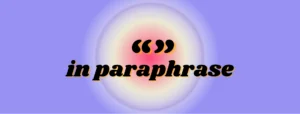
Do You Use Quotation Marks When Paraphrasing
Remember Me
What is your profession ? Student Teacher Writer Other
Forgotten Password?
Username or Email

- Ursuline College
APA 7th edition
About apa 7th edition, in-text citations, secondary source citation, paraphrasing and using quotes, one or more authors, clinical practice references, formatting your paper, who can help.
- APA 6 vs. APA 7 - What's changed?
Online APA resources
- OWL at Purdue APA guide (7th ed.) The Purdue Online Writing Lab is an excellent online version of the APA manual.
- Zbib This is the single-cite citation generator recommended by Ursuline Librarians!
Attribution note:
Most of this guide's content was copied from https://libguides.csudh.edu/citation/apa-7 , a guide created by Tessa Withorn at CSUDH Library and licensed under a Creative Commons Attribution-NonCommercial-Share Alike 4.0 International License . Some content and formatting has been adapted for use at Ursuline College.
This guide is a quick introduction to the American Psychological Association (APA) Style for references and citations. Be sure to consult the Publication Manual of the APA or the APA Style website for detailed standards and procedures.
- A Quick Guide to APA Citation 7th Edition
When you reference another source, use an in-text citation in the body of your paper. There are two ways to reference another source as you write - summarizing/paraphrasing, and direct quotes. Both use the same basic format for in-text citation.
Basic Format: (Author's Last Name(s) or Organization, Year).
In scholarly works, authors reference and cite other works. The APA manual refers to a primary source as the one reporting the original content; the secondary source refers to and cites the primary source. When possible, locate the original or primary source for the information you wish to cite and reference it directly. Otherwise, cite the secondary source as follows:
(Rabbitt, 1982, as cited in Lyon et al., 2014) - Only Lyon et al.'s work appears in the reference list.
Secondary sources are covered in Section 8.6 of the APA Publication Manual, 7th ed., p. 258, and on the APA Style website .
- Paraphrasing and/or summarizing
- Direct quotes
Paraphrasing or summarizing the main findings or takeaways from a research article is the preferred method of citing sources in an APA paper. Always include the last name of the author(s) and the year of the article, so your reader can find the full citation in the reference list.
According to Shavers (2007), limitations of studying socioeconomic status in research on health disparities include difficulties in collecting data on socioeconomic status and the complications of classifying women, children, and employment status.
If you're quoting the exact words of someone else, introduce the quote with an in-text citation in parentheses. Any sentence punctuation goes after the closing parenthesis.
- According to Brown (2019), "Direct quote" (p. 1021).
- Brown (2019) found that "Direct quote" (p. 1021).
- [Some other introduction] "Direct quote" (Brown, 2019, p. 1021).
If you're directly quoting more than 40 words, use a block quote . Block quotes don't need quotation marks. Instead, indent the text 1/2" as a visual cue that you are citing. The in-text citation in parentheses goes after the punctuation of the quote.
Shavers (2007) study found the following:
While research studies have established that socioeconomic status influences disease incidence, severity and access to healthcare, there has been relatively less study of the specific manner in which low SES influences receipt of quality care and consequent morbidity and mortality among patients with similar disease characteristics, particularly among those who have gained access to the healthcare system. (p. 1021)
Use direct quotes sparingly! Focus on summarizing the findings from multiple research studies. In the sciences and social sciences, only use the exact phrasing or argument of an individual when necessary.
- 3 or more authors
- Group author
You only need the author's last name and the year.
(Abrams, 2018)
Connect both authors' last names with & (ampersand) and include the year.
(Wegener & Petty, 1994)
If there are 3 or more authors use et al., which means "and others."
(Harris et al., 2018)
First time with an abbreviation:
(Centers for Disease Control and Prevention [CDC], 2019)
Then all subsequent citations: (CDC, 2019)
- Basic format
- Journal article
- News/Magazine Article
- Book Chapter with Editor(s)
- Psychological Tests
- Online Report
- Cochrane Review
Include the complete citation at the end of your paper in a references section. References are organized by the author's last name in alphabetic (A-Z) order. Apply hanging indent formatting (see below for instructions) to your references to separate them - do not add extra spacing between references.
Basic Format: Author, A. A., & Author, B. B. (Date). Title of the work. Source where you can retrieve the work . URL or DOI if available
How to make a hanging indent in Word:
1. Highlight the citaiton with your cursor.
2. Right click.
3. Select Paragraph .
4. Under Indentation, select Special and Hanging .
- Author(s). Note: List each author's last name and initial as Author, A. A., Author, B. B., & Author, C. C. Use an ampersand (&) before the final author's name. Read more from the APA Style website if there are 21 or more authors.
- Title of the article. Note: For works that are part of a greater whole (e.g. articles, chapter), use sentence case. Only the first word of the title and subtitle and proper nouns are capitalized.
- Title of the Journal , Note: Italicize and capitalize each word in the journal.
- Volume Note: Italicize the journal volume. If there is no issue, include a comma before the page range.
- (Issue), Note: If there is a issue number in addition to a volume number, include it in parentheses.
- Page range.
- DOI (Digital Object Identifier) Read more about DOIs from the APA Style wesbite.
Ashing‐Giwa, K. T., Padilla, G., Tejero, J., Kraemer, J., Wright, K., Coscarelli, A., Clayton, S., Williams, I., & Hills, D. (2004). Understanding the breast cancer experience of women: A qualitative study of African American, Asian American, Latina and Caucasian cancer survivors. Psycho‐Oncology , 13 (6), 408-428. https://doi.org/10.1002/pon.750
- Author(s). Note: List each author's last name and initials as Author, A. A., Author, B. B., & Author, C. C. Use an ampersand (&) before the final author's name.
- (Year, Month Date). Note: You do not need to abbreviate the month.
- Title of the Newspaper or Publication. Note: Italicize and capitalize each word in the publication.
Kennedy, M. (2018, October 15). To prevent wildfires, PG&E pre-emptively cuts power to thousands in California. NPR . https://www.npr.org/2018/10/15/657468903/to-prevent-wildfires-pg-e-preemptively-cuts-power-to-thousands-in-california
- Title of the book. Note: For works that stand alone (e.g. books, reports), italicize the title. Only capitalize the first word of the title and subtitle and any proper nouns.
- (Edition). Note: If there is an edition or volume, include it in parentheses and use abbreviations of ed. or vol.
- Publisher. Note: You do not need to include the publisher location or databases where you retrieved it.
Schmidt, N. A., & Brown, J. M. (2017). Evidence-based practice for nurses: Appraisal and application of research (4th ed.). Jones & Bartlett Learning, LLC.
- Author(s). Note: List each chapter author's last name and initials as Author, A. A., Author, B. B., & Author, C. C. Use an ampersand (&) before the final author's name.
- Title of the chapter. Note: For works that are part of a greater whole (e.g. articles, chapter), use sentence case. Only the first word of the title and subtitle and proper nouns are capitalized.
- In Editor(s), Note: List each editor's last name and initials as A. A. Editor, B. B. Editor, & C. C. Editors, include (Ed.) or (Eds.) in parentheses, and end with a comma.
- Title of the book Note: For works that stand alone (e.g. books, reports), italicize the title. Only capitalize the first word of the title and subtitle and any proper nouns.
- (pp.xx-xx).
McCormack, B., McCance, T., & Maben, J. (2013). Outcome evaluation in the development of person-centred practice. In B. McCormack, K. Manley, & A. Titchen (Eds.), Practice development in nursing and healthcare (pp. 190-211). John Wiley & Sons.
- Author(s). Note: List each author's last name and initials as Author, A. A., Author, B. B., & Author, C. C. If there is no author, spell out the name of the organization or site.
- (Year, Month Date). Note: Read more about date formats from the APA Style website . Provide as specific a date as is available. Use the date last updated, but not the date last reviewed or copyright date. If there is no date, use (n.d.).
- Title of page or section. Note: Italicize the title of the page.
- Source. Note: Usually the official name of the website. If the source would be the same as the author, you can omit the source to avoid repetition.
Centers for Disease Control and Prevention. (n.d.). Preventing HPV-associated cancers . https://www.cdc.gov/cancer/hpv/basic_info/prevention.htm/
Additional examples of citing a webpage on a website:
- Webpage on a news website
- Comment on a webpage on a news website
- Webpage on a website with a government agency group author
- Webpage on a website with an organizational group author
- Webpage on a website with an individual author
- Webpage on a website with a retrieval date
- How to cite a review from Mental Measurements Yearbook
- APA Citations (7th ed.): Tests, Scales, & Inventories
- Author(s). Note: List each author's last name and initials as Author, A. A., Author, B. B., & Author, C. C. If there is no author, spell out the name of the organization that published the report.
- (Year, Month Date). Note: Provide as specific a date as is available.
- Title of the report or document. Note: For works that stand alone (e.g. books, reports), italicize the title. Only capitalize the first word of the title and subtitle and any proper nouns.
- Source. Includes the names of parent agencies or other organizations not listed in the group author name here.
Los Angeles County Department of Public Health. (2017, January). Key indicators of health by service planning area . http://publichealth.lacounty.gov/ha/
- APA Style Blog- How to Cite a Podcast
- How to cite a podcast Citing an etire podcast or a episode
- More examples
- How to cite a Cochrane Review Since Cochrane Reviews are not technically journal articles, there is often debate about the best way to cite them. For those using the 7th edition of the APA manual, Ursuline recommends following guidance provided in the APA 7th edition style blog.
Some resources that are commonly used in clinical nursing practice are confusing to cite. They do not fit into categories like "book" or "article." The APA manual provides examples of such references throughout the 7th edition. For ease of reference, see the consolidated list linked below.
- Clinical practice references This page contains reference examples for clinical practice for nurses, including the following: 1. UpToDate article (Ursuline does not subscribe, but major healthcare providers have access) 2. Cochrane review 3. Clinical practice guideline with a group author 4. Clinical practice guideline by individual authors at a government agency, published as part of a series 5. Drug information 6. Lab or diagnostic manual 7. Mobile app reference work 8. Entry in a mobile app reference work
What does an APA paper look like?
APA Style offers sample student and professional papers , including a free annotated student sample paper .
- Sample Student Paper (APA 7th edition) Download and use this Word document as a template for your paper!
The APA manual provides style rules and guidelines that sometimes require interpretation. Your instructor has the final word , but tutors and librarians can help!
Need help writing your APA paper? Looking for someone to go over what you've written to make sure it's correct? Want someone to review your citations? Email [email protected] and ask to be connected with a writing tutor .
Having trouble citing a particular source? Need help finding the correct citation format? Schedule time to meet with a librarian .
- The Writing Center Make an appointment at the Writing Center for help at any point in the writing or editing process. The Writing Center is located on the second floor of Ursuline Library.
- Next: APA 6 vs. APA 7 - What's changed? >>
- Last Updated: Oct 26, 2023 3:56 PM
- URL: https://libraryguides.ursuline.edu/APA7th

APA Style 7th Edition
- Advertisements
- Books & eBooks
- Book Reviews
- Class Notes, Class Lectures and Presentations
- Encyclopedias & Dictionaries
- Government Documents
- Images, Charts, Graphs, Maps & Tables
- Journal Articles
- Magazine Articles
- Newspaper Articles
- Personal Communication (Interviews & Emails)
- Social Media
- Videos & DVDs
- What is a DOI?
- When Creating Digital Assignments
- When Information is Missing
- Works Cited in Another Source
- In-Text Citation Components
Paraphrasing
- Paper Formatting
- Citation Basics
- Reference List and Sample Papers
- Annotated Bibliography
- Academic Writer
- Plagiarism & Citations
When you write information from a source in your own words, cite the source by adding an in-text citation at the end of the paraphrased portion as follows:
Mother-infant attachment became a leading topic of developmental research following the publication of John Bowlby's studies (Hunt, 1993).
Note : If you refer to the author's name in a sentence you do not have to include the name again as part of your in-text citation, instead include the year of publication following his/her name:
Hunt (1993) noted that mother-infant attachment became a leading topic of developmental research after the publication of John Bowlby's studies.
Paraphrasing Examples
Original Source
Homeless individuals commonly come from families who are riddled with problems and marital disharmony, and are alienated from their parents. They have often been physically and even sexually abused, have relocated frequently, and many of them may be asked to leave home or are actually thrown out, or alternatively are placed in group homes or in foster care. They often have no one to care for them and no one knows them intimately.
Source from:
Rokach, A. (2005). The causes of loneliness in homeless youth. The Journal of Psychology , 139, 469-480.
Example: Incorrect Paraphrasing
The homeless come from families with problems. Frequently, they have been physically or sexually abused, or have lived in group homes. Usually no one cares for them or knows them intimately (Rokach, 2005).
Note : In this incorrect example the writing is too similar to the original source. The student only changed or removed a few words and has not phrased the ideas in a new way.
Example: Correct Paraphrasing
Many homeless experience isolation in part due to suffering from abuse or neglect during their childhood (Rokach, 2005).
Note : The example keeps the idea of the original writing but phrases it in a new way.
In-Text Citation For Two or More Authors/Editors
In-text citation for group or corporate authors, no author and/or no date.
No Known Author:
Note that in most cases where a personal author is not named, a group author may be cited instead (eg. Statistics Canada). However, in certain cases, such as religious ancient texts, the author is unknown. Where you'd normally put the author's last name, instead use the first one, two, or three words from the title. Don't count initial articles like "A", "An" or "The". You should provide enough words to make it clear which work you're referring to from your References List.
If the title in the References list is in italics, italicize the words from the title in the in-text citation.
If you are citing an article, a chapter of a book or a page from a website, put the words in double quotation marks.
Capitalize the titles using title case (every major word is capitalized) even if the reference list entry uses sentence case (only first word is capitalized).
( Cell Biology , 2012, p. 157)
("Nursing," 2011, p. 9)
No Known Date of Publication :
Where you'd normally put the year of publication, instead use the letters "n.d.".
(Smith, n.d., p. 200)
- << Previous: Quoting
- Next: Formatting >>
- Last Updated: Mar 4, 2024 1:55 PM
- URL: https://guides.fscj.edu/APAStyle7

ACAP LEARNING RESOURCES
Reference in APA 7
- Printable Guides & Sample Papers
- Headings & Page Order
- ACAP Presentation Requirements This link opens in a new window
- APA Style Guidelines, Blog & Socials
Paraphrasing
- Time Stamps, Verbatim, Transcripts & Personal Comms
- Secondary Sources
- Tables & Figures
- Missing, Same, Repeated, Multiples, Parts & Abbreviations
- Reference List Elements
- Formatting the Reference List
- DOIs, URLs & Hyperlinks
- Missing Information
- Annotated Bibliographies
- Edited, Republished & Translated Books
- Reference Works
- Diagnostic Manuals (DSM & ICD)
- Religious & Ancient Works
- Newspaper Articles
- Conferences & Theses
- Reports, Policies & Grey Literature
- YouTube & Other Streaming
- Podcasts, TV & Radio
- Transcripts
- Artwork & Images
- Social Media
- Legislation
- Standards & Patents
- Unpublished Works
- Statistics, Tests & Data Sets
- Generative Artificial Intelligence
Running text (Author, Date). Author (Date) running text.
Parenthetical Format . The citation can appear within or at the end of a sentence and includes the author and date separated by a comma. If at the end of a sentence a full stop is placed after the citation. Growth occurs at every stage of life (Newman & Newman, 2017). Case study research does not employ the scientific method (Barlow et al., 2017) although it is an important tool for qualitative researchers (Travers, 2001). Narrative Format . The author is used as part of the text, the date appears directly after the author in parentheses. If the date is used as a part of the text, just separate the author and date with a comma. As discussed by Newman and Newman (2017), growth occurs at every stage of life. In 2019, Hiscock et al. pointed out that half of Australian children and adolescents who experienced mental health issues did not receive professional treatment.
Common Examples
Long Paraphrases & Paragraphs
When paraphrasing or summarising using one source over several sentences or even a whole paragraph, cite the source in the first sentence. There is no need to cite the work again in this paragraph provided it is clear that this is the only source being paraphrased. The APA Style and Grammar Guidelines provide this example:
Velez et al. (2018) found that for women of color, sexism and racism in the workplace were associated with poor work and mental health outcomes, including job-related burnout, turnover intentions, and psychological distress. However, self-esteem, person–organization fit, and perceived organizational support mediated these effects. These findings underscore the importance of considering multiple forms of workplace discrimination in clinical practice and research with women of color, along with efforts to challenge and reduce such discrimination.
You must reintroduce the citation if the paraphrase continues across multiple paragraphs. If the paragraph or sentence contains information from multiple sources, then cite as often as required to make sure the source is clearly acknowledged. The APA Style and Grammar Guidelines provide this example:
Play therapists can experience many symptoms of impaired wellness, including emotional exhaustion or reduced ability to empathize with others (Elwood et al., 2011; Figley, 2002), disruption in personal relationships (Elwood et al., 2011; Robinson-Keilig, 2014), decreased satisfaction with work (Elwood et al., 2011), avoidance of particular situations (Figley, 2002; O’Halloran & Linton, 2000), and feelings or thoughts of helplessness (Elwood et al., 2011; Figley, 2002; O’Halloran & Linton, 2000).
Academic Writer Tutorial: Paraphrasing & Quoting
- << Previous: Citing In-text
- Next: Quotations >>
- Last Updated: Mar 13, 2024 1:57 PM
- URL: https://libguides.navitas.com/apa7

- Book Lists (Under Tuition and Fees)
- Student Gateway
- LIBRARY HOME
APA 7: Paraphrasing
- Formatting Basics
- Dissertations
- Audiovisual Materials
- Classroom Materials
- Reference Works
- Clinical Practice References
- Graphic Materials
- Legal Materials
- Reports and Gray Literature
- Primary Sources
- Paraphrasing
- Verb Tense and Reporting Verbs
- Direct Quotes
- Block Quotes
- In-Text Citation Videos
- Citing Multiple Works
- Reference Section
- Annotated Bibliographies
- Academic Integrity & Plagiarism
- Indigenous Peoples

A paraphrase restates an author's idea in your own words. Paraphrasing is an effective writing strategy because it allows authors to summarize and synthesize information from one or more sources, focus on significant information, and compare and contrast relevant details. You should paraphrase the majority of the time, using direct quotes sparingly, if at all.
Paraphrased In-Text Citations
Narrative in-text citation
Smith (2018) noted that the majority of the users were satisfied with the service they received.
Parenthetical in-text citation
The majority of the users were satisfied with the service they received (Smith, 2018).
Long Paraphrases
When a paraphrase continues for several sentences, cite the work being paraphrased on first mention. Once the work has been cited, it is not necessary to repeat the citation.
Velez et al. (2018) found that for women of color, sexism and racism in the workplace were associated with poor work and mental health outcomes. However, self-esteem and organizational support mediated these effects. These findings underscore the importance of considering multiple forms of workplace discrimination in clinical practice and research with women of color.

Adapted from American Psychological Association publication manual (7th ed.).
- << Previous: In-Text Citations
- Next: Verb Tense and Reporting Verbs >>
- Last Updated: Feb 14, 2024 1:18 PM
- URL: https://tcsedsystem.libguides.com/APA7
× All floors of the JFK Library are open for summer quarter. For details see Library Access
Research Guides
Eastern Washington University Libraries
APA Style 7th Edition Tutorials for Students in Psychology and Social Work
What is apa style.
- The Importance of Citing
Why is APA Style needed?
How do i get started with apa style, let us practice what we have learned, attribution and acknowledgement.
- Basics of APA Style Tutorial
- Reference Entry Elements
- Reference Examples
- Reference List
- In-Text Citations
- Student Paper Format
- Managing References - Zotero
Origination of APA Style
- Where did APA Style come from?
Commonly Used APA Related Terms
Abstract : Abstract is a brief synopses of article. It provides a brief but comprehensive summary of the article.
Citing : In the context of academic writing, citing is the act of acknowledging the sources of information you have used when writing your work.
Citation: A citation gives credit to a source, and contains publication information such as author(s), title and date.
DOI (digital object identifier): It is a unique alphanumeric string assigned to a digital object, mainly a scholarly article, to provide a persistent link to its location on the internet.
In-Text Citation : It is a brief note that appears within the body of the paper and briefly identifies the cited work by its author and date of publication. An in-text citation should always match the corresponding entry in the reference list at the end of paper.
Paraphrasing : A paraphrase restates another’s idea (or your own previously published idea) in your own words.
Plagiarism : It is the act of presenting the words, ideas, or images of another as your own; it denies creators of content the credit they are due.
Quoting : It is the act of reproducing the exact wording used by the original author. Direct quotations appear within quotation marks and end with a citation.
Reference : It contains details about one cited work, generally including four elements: author, date, title, and source.
Reference List : It identifies all the sources you cited in the text of your paper. It generally is at the end of the paper and definitely on a new page after the text of your paper.
APA Style is the most common writing style used in college and career. Its purpose is to promote excellence in communication by helping writers create clear, precise, and inclusive sentences with a straightforward scholarly tone. It addresses areas of writing such as how to
- format a paper so it looks professional;
- credit other people’s words and ideas via citations and references to avoid plagiarism; and
- describe other people with dignity and respect using inclusive, bias-free language.
APA Style is primarily used in the behavioral sciences, which are subjects related to people, such as psychology, education, and nursing. It is also used by students in business, engineering, communications, and other classes. Students use it to write academic essays and research papers in college, and professionals use it to conduct, report, and publish scientific research.
In addition, APA Style provides you with a powerful tool that will hep you avoid deliberate or unintentional plagiarism. Please review the Avoiding Plagiarism Guide created by the APA experts to understand what two common types of plagiarism are and how to avoid them.
Why is learning citations important? Citations help readers understand where the information used in your paper comes from, enabling them to trace the path of that information. When readers wish to explore a specific point or reference cited in the text, citations make it easier by providing information about your sources in a standardized format.
Besides showing readers where you obtained information, using citations also has a strong ethical purpose. In academic writing, it is important to credit ideas that are not your own. Citations allow you to integrate the ideas of others with your own thoughts in a fair and honest way.
The reference formats for APA Style manuals are as follows:
APA Style provides a foundation for effective scholarly communication because it helps authors present their ideas in a clear and concise, and organized manner. Uniformity and consistency enable readers to (a) focus on the ideas being presented rather than formatting and (b) scan works quickly for key points, findings, and sources. When style works best, ideas flow logically, sources are credited appropriately, and papers are organized predictably and consistently.
Students are encouraged to first learn about APA Style by reading works written in APA Style. A couple of guides created by APA experts from the American Psychological Association can help you with that:
Anatomy of a Journal Article https://apastyle.apa.org/instructional-aids/anatomy-journal-article.pdf
Scholarly journal articles share a common anatomy or structure. Each part of an article serves a specific purpose. The handout of Anatomy of a Journal Article explains how journal articles are structured and how to become more efficient at reading and understanding them. Understanding the structure of a scholarly article and the purpose of each part helps you grasp a strategy called targeted reading. Targeted reading means to read specific sections of research articles first to determine if the article seems useful for your research topic. This way you will save time, find useful article faster, and choose which articles to read in full.
Reading and Understanding Abstracts https://apastyle.apa.org/instructional-aids/reading-abstracts.pdf
Abstracts are short summaries of scientific research articles. The handout of Reading & Understanding Abstracts explains the definition and purpose of abstracts and the benefits of reading them, including analysis of a sample abstract. The skill of reading and understanding abstracts of scholarly articles not only saves time but also helps you conduct better research and write more effectively.
APA Style Writing Principles https://apastyle.apa.org/instructional-aids/writing-principles.pdf
The poster created by APA experts shows the three main principles of APA Style: clarity, precision, and inclusion and lists steps on how to achieve them. As a student writer, you always should write your academic paper with clarity, precision, and inclusion.
Research Article Activity https://apastyle.apa.org/instructional-aids/apa-style-research-activity.pdf
Reading research articles is not an easy task for you as a student. The Research Article Activity designed by APA Style experts aims to make it easy to read and understand a scholarly article. This activity worksheet helps you find, cite, analyze, and summarize a research article. Completing this activity breaks down a lengthy research article into easily understandable chunks. This way helps you better understand the study in the article before you write about it.
The information in this Guide is courtesy of the official APA Style website by the American Psychological Association.
Source Credit: Information on this LibGuide comes from APA Style website https://apastyle.apa.org/ This website has a wealth of free and authoritative resources designed to help anyone new to APA Style.
- Next: Basics of APA Style Tutorial >>
- Last Updated: Apr 6, 2024 12:06 PM
- URL: https://research.ewu.edu/APAStyleTutorial

APA Citation and Paper Formatting Guide (APA 7th Edition): Paraphrasing
- Books & ebooks
- Journal Articles (academic, scholarly, peer-reviewed)
- Magazine Articles
- Newspaper Articles
- Encyclopedias, Dictionaries, & Wikipedia (Reference Works)
- Films, Videos, & YouTube
- Music & Podcasts (Audio Works)
- Art, Photography, & Images (Visual Works)
- Social Media
- Class Notes, Class Lectures and Presentations (PowerPoint)
- Personal Communication (Interviews, Emails)
- Works Quoted in Another Source
- When Information Is Missing
- Can't Find What You're Looking For?
Paraphrasing
- Sample Papers and Reference Lists
Additional Resources
In-text basics (paraphrasing).
When using APA format, follow the author-date method of in-text citation. This means that the author's last name and the year of publication for the source should appear in the text, like, for example, (Jones, 1998). One complete reference for each source should appear in the reference list at the end of the paper.
If you are referring to an idea from another work but NOT directly quoting the material (i.e. paraphrasing ), or making reference to an entire book, article or other work, you only have to make reference to the author and year of publication and not the page number in your in-text reference. APA guidelines, however, do encourage including a page range for a summary or paraphrase when it will help the reader find the information in a longer work.
Regardless of how they are referenced, all sources that are cited in the text must appear in the reference list at the end of the paper.
Source: Purdue OWL
When you write information from a source in your own words, cite the source by adding an in-text citation at the end of the paraphrased portion as follows:
Mother-infant attachment became a leading topic of developmental research following the publication of John Bowlby's studies (Hunt, 1993).
If you refer to the author's name in a sentence you do not have to include the name again as part of your in-text citation, instead include the year of publication following his/her name:
Hunt (1993) noted that mother-infant attachment became a leading topic of developmental research after the publication of John Bowlby's studies.
Paraphrasing Examples
Original Source
Homeless individuals commonly come from families who are riddled with problems and marital disharmony, and are alienated from their parents. They have often been physically and even sexually abused, have relocated frequently, and many of them may be asked to leave home or are actually thrown out, or alternatively are placed in group homes or in foster care. They often have no one to care for them and no one knows them intimately.
Source from:
Rokach, A. (2005). The causes of loneliness in homeless youth. The Journal of Psychology , 139, 469-480. Retrieved from Academic Search Premier database.
Example: Incorrect Paraphrasing
The homeless come from families with problems. Frequently, they have been physically or sexually abused, or have lived in group homes. Usually no one cares for them or knows them intimately (Rokach, 2005).
Note : In this incorrect example the writing is too similar to the original source. The student only changed or removed a few words and has not phrased the ideas in a new way.
Example: Correct Paraphrasing
Many homeless experience isolation in part due to suffering from abuse or neglect during their childhood (Rokach, 2005).
Note : The example keeps the idea of the original writing but phrases it in a new way.
Three or More Authors/Editors (In-text citations)
No author and/or no date.
No Known Author:
Where you'd normally put the author's last name, instead use the first one, two, or three words from the title. Don't count initial articles like "A", "An" or "The". You should provide enough words to make it clear which work you're referring to from your References List.
If the title in the References list is in italics, italicize the words from the title in the in-text citation.
If you are citing an article, a chapter of a book or a page from a website, put the words in double quotation marks.
( Cell Biology , 2012)
("Nursing," 2011)
No Known Date of Publication :
Where you'd normally put the year of publication, instead use the letters "n.d.".
(Smith, n.d.)
More Than One Author/Editor
Two Authors or Editors
Provide each author's last name and the year of publication each time you cite the work in-text.
Three or More Authors or Editors
Provide the first author's last name followed by "et al.," and the year of publication every time you cite the work in-text.
Have a question about paraphrasing or in-text citations that isn't answered on this page? Check out these sites for more detailed information:
- Paraphrasing (American Psychological Association)
- In-Text Citations (American Psychological Association)
- APA In-Text Citations (Excelsior OWL)
- << Previous: Quoting
- Next: Sample Papers and Reference Lists >>
- Last Updated: Sep 5, 2023 12:04 PM
- URL: https://lib.lavc.edu/apa


- Joyner Library
- Laupus Health Sciences Library
- Music Library
- Digital Collections
- Special Collections
- North Carolina Collection
- Teaching Resources
- The ScholarShip Institutional Repository
- Country Doctor Museum
APA Citation Style, 7th Edition: In-Text Citations & Paraphrasing
- APA 6/7 Comparison Guide
- New & Notable Changes
- Student Paper Layout
- Journal Article with One Author
- Journal Article with Two Authors
- Journal Article with Three or more Authors
- Help?! I can't find the DOI
- One Author/Editor
- Two Authors/Editors
- Chapter in a Book
- Electronic Books
- Social Media Posts
- YouTube or other streaming video
- Podcast or other audio works
- Infographic, Powerpoint, or other visual works
- Government Websites & Publications, & Gray Literature
- Legislative (US & State House & Senate) Bills
- StatPearls, UpToDate, DynaMedex
- Dissertations & Thesis
- Interviews & Emails
- Magazine Articles
- Newspaper Articles
- Datasets, Software, & Tests
- Posters & Conference Sessions
- Photographs, Tables, & PDF's
- Canvas Posts & Class Discussion Boards
- In-Text Citations & Paraphrasing
- References Page
- Free APA 7th edition Resources, Handouts, & Tutorials
When do I use in-text citations?
When should you add in-text citations in your paper .
There are several rules of thumb you can follow to make sure that you are citing your paper correctly in APA 7 format.
- Think of your paper broken up into paragraphs. When you start a paragraph, the first time you add a sentence that has been paraphrased from a reference -> that's when you need to add an in-text citation.
- Continue writing your paragraph, you do NOT need to add another in-text citation until: 1) You are paraphrasing from a NEW source, which means you need to cite NEW information OR 2) You need to cite a DIRECT quote, which includes a page number, paragraph number or Section title.
- Important to remember : You DO NOT need to add an in-text citation after EVERY sentence of your paragraph.

What do in-text citations look like?
In-text citation styles: , let's look at these examples if they were written in text: .
An example with 1 author:
Parenthetical citation: Following American Psychological Association (APA) style guidelines will help you to cultivate your own unique academic voice as an expert in your field (Forbes, 2020).
Narrative citation : Forbes (2020) shared that by following American Psychological Association (APA) guidelines, students would learn to find their own voice as experts in the field of nursing.
An example with 2 authors:
Parenthetical citation: Research on the use of progressive muscle relaxation for stress reduction has demonstrated the efficacy of the method (Bennett & Miller, 2019).
Narrative citation: As shared by Bennett and Miller (2019), research on the use of progressive muscle relaxation for stress reduction has demonstrated the efficacy of the method.
An example with 3 authors:
Parenthetical citation: Guided imagery has also been shown to reduce stress, length of hospital stay, and symptoms related to medical and psychological conditions (Jones et al., 2020).
Narrative citation: Jones et al. (2020) shared that guided imagery has also been shown to reduce stress, length of hospital stay, and symptoms related to medical and psychological conditions.
An example with a group/corporate author:
Parenthetical citation: Dr. Philip G. Rogers, senior vice president at the American Council on Education, was recently elected as the newest chancellor of the university (East Carolina University, 2020).
Narrative citation: Recently shared on the East Carolina University (2020) website, Dr. Philip G. Rogers, senior vice president at the American Council on Education, was elected as the newest chancellor.
Tips on Paraphrasing
Paraphrasing is recreating someone else's ideas into your own words & thoughts, without changing the original meaning (gahan, 2020). .
Here are some best practices when you are paraphrasing:
- How do I learn to paraphrase? IF you are thoroughly reading and researching articles or book chapters for a paper, you will start to take notes in your own words . Those notes are the beginning of paraphrased information.
- Read the original information, PUT IT AWAY, then rewrite the ideas in your own words . This is hard to do at first, it takes practice, but this is how you start to paraphrase.
- It's usually better to paraphrase, than to use too many direct quotes.
- When you start to paraphrase, cite your source.
- Make sure not to use language that is TOO close to the original, so that you are not committing plagiarism.
- Use theasaurus.com to help you come up with like/similar phrases if you are struggling.
- Paraphrasing (vs. using direct quotes) is important because it shows that YOU ACTUALLY UNDERSTAND the information you are reading.
- Paraphrasing ALLOWS YOUR VOICE to be prevalent in your writing.
- The best time to use direct quotes is when you need to give an exact definition, provide specific evidence, or if you need to use the original writer's terminology.
- BEST PRACTICE PER PARAGRAPH: On your 1st paraphrase of a source, CITE IT. There is no need to add another in-text citation until you use a different source, OR, until you use a direct quote.
References :
Gahan, C. (2020, October 15). How to paraphrase sources . Scribbr.com . https://tinyurl.com/y7ssxc6g
Citing Direct Quotes
When should i use a direct quote in my paper .
Direct quotes should only be used occasionally:
- When you need to share an exact definition
- When you want to provide specific evidence or information that cannot be paraphrased
- When you want to use the original writer's terminology
From: https://americanlibrariesmagazine.org/whaddyamean/
Definitions of direct quotes:
- Western Oregon University's APA Guidelines on Direct Quotes This is an excellent quick tutorial on how to format direct quotes in APA 7th edition. Bookmark this page for future reference!
Carrie Forbes, MLS

Chat with a Librarian

Chat with a librarian is available during Laupus Library's open hours .
Need to contact a specific librarian? Find your liaison.
Call us: 1-888-820-0522 (toll free)
252-744-2230
Text us: 252-303-2343
- << Previous: Canvas Posts & Class Discussion Boards
- Next: References Page >>
- Last Updated: Jan 12, 2024 10:05 AM
- URL: https://libguides.ecu.edu/APA7

APA 7: Quote & Paraphrase
- Paper Sections
- Quote & Paraphrase
- Format in Word
- In-Text Citations
- Reference List
- Sample Paper
Paraphrase or Summarize
When you paraphrase, you restate the ideas of another writer in your own words. A summary shortens information into a more general statement. For the in-text citation, APA requires the name of the author (or the work's title if the author is unknown) and the year of publication.
- Vonnegut (1982) explains that when writers do not structure and organize their information in meaningful ways, the reader will feel neglected.
- When writers do not structure and organize their information in meaningful ways, the reader will feel neglected (Vonnegut, 1982).
APA encourages including a page range for a summary or paraphrase if it will help the reader find the information in a longer work.
- Paraphrasing - APA Style Guide
Use quotations when you directly quote a source word-for-word in your paper. Use direct quotations when you need an exact definition or when an author has said something memorable or succinctly.
Short Quotations
Short quotations have fewer than 40 words. They require the author, year of publication, and page number (preceded by p.). Place quotation marks around the quote.
- "If you scribble your thoughts any which way, your readers will surely feel that you care nothing about them" (Vonnegut, 1982, p. 150).
Or, with the signal phrase:
- According to Vonnegut (1982), "If you scribble your thoughts any which way, your readers will surely feel that you care nothing about them" (p. 150).
Partial Quotes
If you decide to leave out part of a quotation within your paper, you must still let your reader know that you have left out part of the quote. This is where an ellipsis (...) is needed.
- In "How to Write with Style," famed sci-fi writer Kurt Vonnegut (1982) notes that "I myself find that I trust my writing...when I sound most like a person from Indianapolis" (p. 152).
Long Quotations (Block Quotations)
Quotes longer than 40 words need to be block quotations:
- Do not use quotation marks around the quote.
- Start a block quote on a new line and indent the whole block 0.5 inches from the left margin.
- Double-space the quotation and do not add an extra line before or after it.
- Either cite the source in parentheses after the quotation’s final punctuation or cite the author and year in your paper before the quotation and place only the page number in parentheses after the quotation’s final punctuation.
- Do not add a period after the closing parenthesis.
Researchers have studied how people talk to themselves:
- Quotations - APA Style Guide
- << Previous: Paper Sections
- Next: Format in Word >>
Free Paraphrasing Tool
Try our other writing services

Avoid plagiarism in your paraphrased text
People are in love with our paraphrasing tool.

No Signup Needed
You don’t have to register or sign up. Insert your text and get started right away.


The Paraphraser is Ad-Free
Don’t wait for ads or distractions. The paraphrasing tool is ad-free!

Multi-lingual
Use our paraphraser for texts in different languages.

What's a paraphrasing tool?
This AI-powered paraphraser lets you rewrite text in your own words. Use it to paraphrase articles, essays, and other pieces of text. You can also use it to rephrase sentences and find synonyms for individual words. And the best part? It’s all 100% free!

What's paraphrasing?
Paraphrasing involves expressing someone else’s ideas or thoughts in your own words while maintaining the original meaning. Paraphrasing tools can help you quickly reword text by replacing certain words with synonyms or restructuring sentences. They can also make your text more concise, clear, and suitable for a specific audience. Paraphrasing is an essential skill in academic writing and professional communication.

Why use this paraphrasing tool?
- Save time: Gone are the days when you had to reword sentences yourself; now you can rewrite a text or a complete text with one click.
- Improve your writing: Your writing will always be clear and easy to understand. Automatically ensure consistent language throughout.
- Preserve original meaning: Paraphrase without fear of losing the point of your text.
- No annoying ads: We care about the user experience, so we don’t run any ads.
- Accurate: Reliable and grammatically correct paraphrasing.
- No sign-up required: We don’t need your data for you to use our paraphrasing tool.
- Super simple to use: A simple interface even your grandma could use.
- It’s 100% free: No hidden costs, just unlimited use of a free paraphrasing tool.
Features of the paraphrasing tool

Rephrase individual sentences
With the Scribbr Paraphrasing Tool, you can easily reformulate individual sentences.
- Write varied headlines
- Rephrase the subject line of an email
- Create unique image captions

Paraphrase a whole text
Our paraphraser can also help with longer passages (up to 125 words per input). Upload your document or copy your text into the input field.
With one click, you can reformulate the entire text.

Find synonyms with ease
Simply click on any word to open the interactive thesaurus.
- Choose from a list of suggested synonyms
- Find the synonym with the most appropriate meaning
- Replace the word with a single click

Paraphrase in two ways
- Standard: Offers a compromise between modifying and preserving the meaning of the original text
- Fluency: Improves language and corrects grammatical mistakes.

Upload different types of documents
Upload any Microsoft Word document, Google Doc, or PDF into the paraphrasing tool.

Download or copy your results
After you’re done, you can easily download or copy your text to use somewhere else.

Powered by AI
The paraphrasing tool uses natural language processing to rewrite any text you give it. This way, you can paraphrase any text within seconds.

Avoid accidental plagiarism
Want to make sure your document is plagiarism-free? In addition to our paraphrasing tool, which will help you rephrase sentences, quotations, or paragraphs correctly, you can also use our anti-plagiarism software to make sure your document is unique and not plagiarized.
Scribbr’s anti-plagiarism software enables you to:
- Detect plagiarism more accurately than other tools
- Ensure that your paraphrased text is valid
- Highlight the sources that are most similar to your text
Start for free
How does this paraphrasing tool work?
1. put your text into the paraphraser, 2. select your method of paraphrasing, 3. select the quantity of synonyms you want, 4. edit your text where needed, who can use this paraphrasing tool.

Paraphrasing tools can help students to understand texts and improve the quality of their writing.

Create original lesson plans, presentations, or other educational materials.

Researchers
Explain complex concepts or ideas to a wider audience.

Journalists
Quickly and easily rephrase text to avoid repetitive language.

Copywriters
By using a paraphrasing tool, you can quickly and easily rework existing content to create something new and unique.

Bloggers can rewrite existing content to make it their own.

Writers who need to rewrite content, such as adapting an article for a different context or writing content for a different audience.

A paraphrasing tool lets you quickly rewrite your original content for each medium, ensuring you reach the right audience on each platform.
The all-purpose paraphrasing tool
The Scribbr Paraphrasing Tool is the perfect assistant in a variety of contexts.

Brainstorming
Writer’s block? Use our paraphraser to get some inspiration.

Professional communication
Produce creative headings for your blog posts or PowerPoint slides.

Academic writing
Paraphrase sources smoothly in your thesis or research paper.

Social media
Craft memorable captions and content for your social media posts.
Paraphrase text online, for free
The Scribbr Paraphrasing Tool lets you rewrite as many sentences as you want—for free.
Write with 100% confidence 👉
Ask our team.
Want to contact us directly? No problem. We are always here for you.
- Email [email protected]
- Start live chat
- Call +1 (510) 822-8066
- WhatsApp +31 20 261 6040

Frequently asked questions
The act of putting someone else’s ideas or words into your own words is called paraphrasing, rephrasing, or rewording. Even though they are often used interchangeably, the terms can mean slightly different things:
Paraphrasing is restating someone else’s ideas or words in your own words while retaining their meaning. Paraphrasing changes sentence structure, word choice, and sentence length to convey the same meaning.
Rephrasing may involve more substantial changes to the original text, including changing the order of sentences or the overall structure of the text.
Rewording is changing individual words in a text without changing its meaning or structure, often using synonyms.
It can. One of the two methods of paraphrasing is called “Fluency.” This will improve the language and fix grammatical errors in the text you’re paraphrasing.
Paraphrasing and using a paraphrasing tool aren’t cheating. It’s a great tool for saving time and coming up with new ways to express yourself in writing. However, always be sure to credit your sources. Avoid plagiarism.
If you don’t properly cite text paraphrased from another source, you’re plagiarizing. If you use someone else’s text and paraphrase it, you need to credit the original source. You can do that by using citations. There are different styles, like APA, MLA, Harvard, and Chicago. Find more information about citing sources here.
Paraphrasing without crediting the original author is a form of plagiarism , because you’re presenting someone else’s ideas as if they were your own.
However, paraphrasing is not plagiarism if you correctly cite the source . This means including an in-text citation and a full reference, formatted according to your required citation style .
As well as citing, make sure that any paraphrased text is completely rewritten in your own words.
Plagiarism means using someone else’s words or ideas and passing them off as your own. Paraphrasing means putting someone else’s ideas in your own words.
So when does paraphrasing count as plagiarism?
- Paraphrasing is plagiarism if you don’t properly credit the original author.
- Paraphrasing is plagiarism if your text is too close to the original wording (even if you cite the source). If you directly copy a sentence or phrase, you should quote it instead.
- Paraphrasing is not plagiarism if you put the author’s ideas completely in your own words and properly cite the source .
Try our services

How to Paraphrase in APA Format
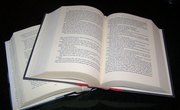
How to Do In-Text Citations in a Research Paper
Paraphrasing is an important skill to acquire in your writing. It allows you to put ideas from sources into your own words and avoid quoting large blocks of text. Even if you paraphrase a source instead of quoting it, American Psychological Association format requires you to cite the text that the paraphrased information comes from .
Guidelines for Paraphrasing
Paraphrasing is not just rearranging the words used in your source, or rewriting a sentence using different vocabulary. The language and phrasing you use in a paraphrased sentence should be your own, and sound like the writing you use in the rest of your essay. If the first attempt at your paraphrased sentence is too close to the original, rewrite your sentence with a different arrangement of words and different vocabulary. If you repeat a phrase of two or more words from your source , you should put this phrase in quotes to signify its origin. If you cannot write a paraphrasing of your source that you are satisfied with, quote directly from your source instead.
Citing Paraphrased Material in APA Style
Whenever you paraphrase material in APA format, you must place an in-text citation in your paper, noting the source you paraphrased. An in-text citation is closed in parentheses, and contains the last name of the source's author and the year the source was published. You may also include the page number of the cited information, though this is not required for paraphrased references. Note that other writing styles will require different information for this in-text citation -- Modern Language Association, for instance, requires only author name and page number. For example, say you were paraphrasing in APA the following sentence from Mircea Eliade's "The Myth of the Eternal Return":
"In fact, the myths of many peoples allude to a very distant epoch when men knew neither death nor toil nor suffering and had a bountiful supply of food merely for the taking."
A paraphrasing of this sentence, with an in-text citation, might look as follows:
One recurring theme in mythology is an ancient time period where humanity lived without the threat of starvation or the burdens of work and pain (Eliade, 2005, p. 91).
Related Articles
How to do citations for paradise lost.

How to Write a Paraphrase

What if I Don't Have a Page Number in an MLA In-Text Citation?

How to Do Quotes on an Argumentative Essay in MLA Format
How to quote lists in mla format, how to cite the 4th amendment.

How to Write High School Research Papers

How to write a humanities paper
- APA Style Blog: Citing Paraphrased Work in APA Style
- Williams College: Tips on Paraphrasing
- Purdue University Online Writing Lab: Quoting, Paraphrasing, and Summarizing
Jon Zamboni began writing professionally in 2010. He has previously written for The Spiritual Herald, an urban health care and religious issues newspaper based in New York City, and online music magazine eBurban. Zamboni has a Bachelor of Arts in religious studies from Wesleyan University.

John Gray Park '28 Library
- How Do I...
- Library Map
- Library Databases
- NoodleTools
- Research Guides
- Newspapers & Magazines
- Academic Resource Center (ARC)
- ARC Appointments
- Faculty & Staff
- Peer Tutoring
Citation and Writing
- How to cite specific sources
- How to make a Works Cited
- How to write an Annotated Bibliography
- How to format In-Text Citations
- How to Paraphrase
- How to integrate Quotations and Paraphrases
- How to format Footnotes and Endnotes
- How to make a Bibliography
- How to cite Primary Sources
- How to make a Reference Page
How to Paraphrase Video
What is a Paraphrase
A paraphrase translates the source’s words into your own voice and your own words. If you copy three or more words in a row, you must put those words in quotation marks and name the source. Just like a quotation, a paraphrase is always cited in your paper and on a separate page at the end.
5 Steps to Effective Paraphrasing
- Read your passage until you comprehend its full meaning. As you read, jot down bullet points on the facts or opinions presented, but do not copy "word for word" without using quotation marks.
- Put your passage aside, and write out your paraphrase in full sentences. Try u sing the notecard feature in NoodleTools and view your notes in 'detail view'.
- Check your version with the original to ensure accuracy. Make any corrections about facts or details.
- Use quotation marks to identify any unique phrases that you may have used directly from the source. The 'detail view' in NoodleTools lets you look at the original passage with your paraphrase below it to easily compare.
- Record the source and page number so that you can refer back to it later when creating your citations.
Adapted from the Purdue Online Writing Lab's Guide to Paraphrasing .
Use Paraphrase Indicators to...
- Present research as fact
- Demonstrate analysis
- Support ideas
- Question an idea
When an author has conducted valid research via scientific methods and data collection, their findings may be presented as evidence of fact. Evaluate the credibility of your source (author's credentials + research methodology), then introduce your paraphrase using assertive language such as:
According to Cowell....
Brovick shows …, gard finds/found that…, hatton has determined ....
* Special thanks to Lora Cowell and Nancy Florio for permission to use this information.
Scholars use evidence gathered through research to develop theories. This interpretation of findings is not always black and white. If an author's interpretation is debatable, present their ideas as "analysis or opinion." You can begin the paraphrase of such ideas with phrases such as:
Moberg hypothesizes …
Scott maintains that…, van berkum predicts …, butterfield suggests ….
Use multiple credible authors to support and strengthen your arguments. Be sure that the authors are agreeing with the idea based on their own analysis and expertise. Start by paraphrasing the original idea (with citation), following with a paraphrase of agreement, such as:
Miller acknowledges …
Parker confirms ..., andrews verifies ..., fritz substantiates ....
Controversial topics generate multiple viewpoints. Acknowledge viewpoints that oppose your main thesis and then COUNTER with evidence or interpretations to support the opposing view. Introduce the opposing viewpoint with a phrase such as:
Anderson argues …
Parker contends ...
Speigle disagrees ..., jenkins responds ….
- << Previous: How to make a Reference Page
- Next: How to integrate Quotations and Paraphrases >>
- Last Updated: Oct 2, 2023 8:43 AM
- URL: https://libguides.kent-school.edu/citeandwrite
Purdue Online Writing Lab Purdue OWL® College of Liberal Arts
APA Formatting and Style Guide (7th Edition)

Welcome to the Purdue OWL
This page is brought to you by the OWL at Purdue University. When printing this page, you must include the entire legal notice.
Copyright ©1995-2018 by The Writing Lab & The OWL at Purdue and Purdue University. All rights reserved. This material may not be published, reproduced, broadcast, rewritten, or redistributed without permission. Use of this site constitutes acceptance of our terms and conditions of fair use.
In-Text Citations
Resources on using in-text citations in APA style
Reference List
Resources on writing an APA style reference list, including citation formats
Other APA Resources
- Have your assignments done by seasoned writers. 24/7
- Contact us:
- +1 (213) 221-0069
- [email protected]

How to Paraphrase in APA and MLA: Full Guide to Scoring High
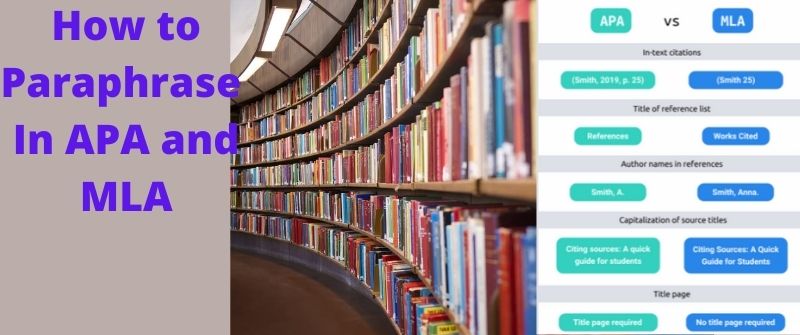
How to Paraphrase In APA and MLA
When writing an academic paper using either APA or MLA formats, you are required to produce plagiarism-free content. This is because it is an academic crime to plagiarize another writer’s work and present it as your own. To avoid plagiarism in academic writing, one of the best methods used is paraphrasing.
Paraphrasing can be regarded as the act of rewriting or restating the meaning of the original passage or text using your own words.
When researching for your academic papers, you will find and include information and ideas collected from the sources in your paper. You are required to put the ideas or information in your own words to avoid plagiarism.

Paraphrasing in either APA or MLA formats takes different forms. This essay will provide you with detailed descriptions of how you are supposed to paraphrase original texts using the two academic writing formats.
If you need such services, check our essay paraphrasing service and get yourself a new paper from a rather old one.
Need Help with your Homework or Essays?
How to paraphrase in apa.
The APA format is among the most commonly used writing formats in academic writing.
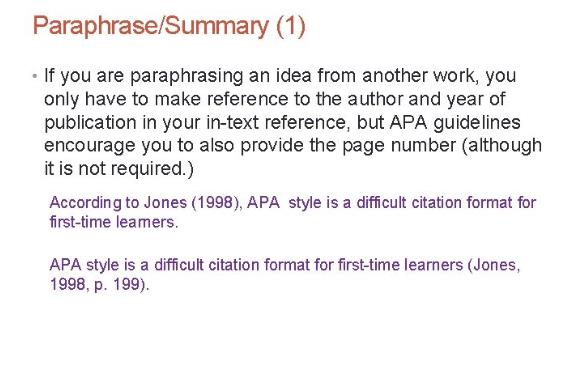
There is a great chance that your instructor has required you to write essays or research papers using this format.
As such, it is important to learn how to paraphrase appropriately using the format to impress the instructor and get good grades.
1. Read and Understand the Source
Reading and understanding the source of information is the first step you need to take before paraphrasing any text.
This not only applies to the APA format but other academic writing formats too and other forms of writing. You simply cannot rewrite something in your own words in such a way that you retain the original meaning if you have not read and understood the text.
When you have fully understood the original text, its meaning, and the points it intends to pass to the reader, then you can rewrite it into your APA formatted paper or essay.
2. Identify the Main Points
After you have read the text and understood its meaning, you should identify the main points and any information that supports the points. This narrows down your scope in such a way that you will not have to rewrite everything.
You will only need to identify the main points that relate to the claims in your APA formatted paper and the supporting information that you will paraphrase.
Rewriting or paraphrasing everything from the original text would not make sense because not everything is important for your paper.
Not everything from the source will effectively and appropriately support your claims. Therefore, identify the main points and the supporting information.
3. Rewriting
The next step in paraphrasing using APA format is to rewrite the selected portions of the original text in your own words. It is very important to avoid the usage of similar sentence structure or phrasing because your paper will be flagged by plagiarism-checking tools.
4. Use of Lead-ins
When rewriting or paraphrasing the original text, you can use lead-ins to signal to the readers that you are about to paraphrase what another person has said. Such lead-ins can include “according to…”, “as the author(s) state…”, “as the text/book/journal/article notes…”
Once you are done with the aforementioned steps, you should compare the paraphrased text with the original text. Make sure that your new text conveys the same meaning as the original text. Furthermore, the phrasing and the sentence structure should not be similar.
5. Including a Citation
This is the most important step when paraphrasing using the APA format. When you paraphrase any text, you should make sure that the author of the original text or the source of your information has been given credit using an in-text citation.
Here, you are required to provide the author’s surname and the year they published their work. It should be enclosed in brackets, for example (Jonathan, 2021).
Citing Quotes, Paraphrases, and Summaries in APA
As aforementioned, citing is very important when you use another writer’s ideas or work in your paper. You should format the citations using the appropriate APA style, in this case, the 7th edition.
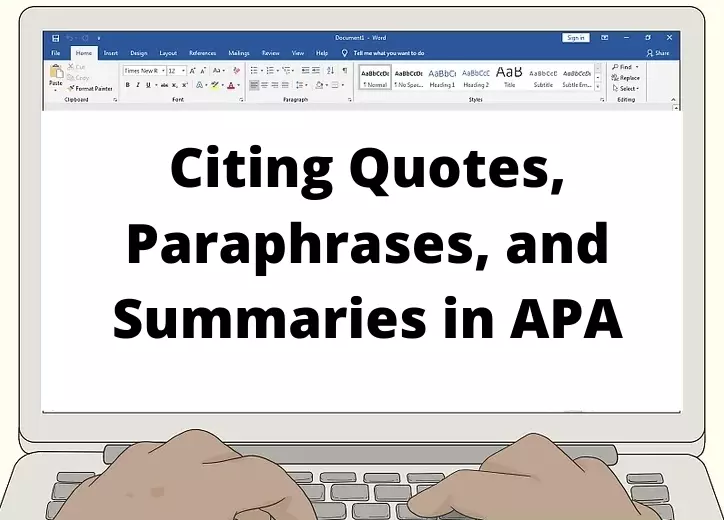
When quoting, you only need to copy-paste the original text into your paper.
Once you have done that, enclose the text using quotation marks (“…”) and italicize it.
On the other hand, when you are summarizing the original text, you only need to express the main points in your paper.
Whether paraphrasing, quoting, or summarizing the original text, you are required to appropriately cite the source using the proper APA format at the end of the text.
Citing paraphrases, quotes, or summaries in APA is standard. You only need to state the author’s surname the year their work was published, and enclose them using brackets.
For example, if you have quoted, summarized, or paraphrased an author called Jonathan, who published their work in 2021, the citation at the end of the sentence should be (Jonathan, 2021). Ensure that you separate the author and the year using a comma.
Citing two authors should appear like this: (Jonathan & Mark, 2021). When three or more authors have written a source, include the surname of the first author and add an “et al.” to it. It would look like this: (Jonathan et al., 2021).
How to Cite Paraphrased Information in APA from a Website, Book, and News
When citing paraphrased information from a website, you should include the author of the information and the year they posted the information on the website.
If the author’s name is not given, write the name of the website instead. If the date is not provided, use “n.d.”, which means “no date” provided”. Format it as aforementioned.
Concerning a book, you should include the author’s surname and the year the book was published, just as described above. When it comes to news, you should provide the name of the news network followed by the date it was broadcast.
How to Paraphrase in MLA
Paraphrasing in MLA takes the same strategy as in APA. You only need to read and understand the source of the information, take note of the main points and their supporting arguments that will help you in your paper, and rewrite the source of information in your own words.
You should also make sure that the phrasing and sentence structure are not similar to the original text because your work will be plagiarized.
Furthermore, make sure that you properly or appropriately cite the source of the information using MLA format. This is where the big difference between APA and MLA comes in in this case. The structure of the citations is different; hence, you should be very careful.
Get a Brilliant Essay today!
Let our essay writing experts help you get that A in your next essay. Place your order today, and you will enjoy the benefits.
How to Cite Quotes in MLA
As noted within the APA section within this article, when quoting, you only need to copy-paste the original text into your paper. Once you have done that, enclose the text using quotation marks (“…”) and italicize it. This is similar across the board because there is no other way of quoting text in your academic papers.

However, the difference is in citations.
MLA citations or in-text citations require you to include the author’s surname followed by the page number of the source of your information.
Note that you are not required to provide the year but the page number after the author’s surname.
The surname and the page number are not separated by a comma. They are only separated by a space.
For example, if Mark Jonathan wrote a paper and you want to quote some information from page 11 of the paper, then your MLA citation will look like this: (Jonathan 11). This should immediately follow the quote to ensure that you have not plagiarized the quote.
If you have two authors, your MLA citation should appear like this: (Jonathan & Martin 11). Note that there is still no comma used to separate the authors and the page number.
If the authors are three and above, your citation should appear like this: (Jonathan et al. 11). You should also note that there is no comma in this case. Only a space separates “et al.” and the page number.
How to Cite Paraphrasing in MLA
Paraphrasing in MLA is similar to how you paraphrase in APA because paraphrasing takes a similar strategy. You only need to rewrite the information in your own words in such a way that it retains the same meaning and points.
Use the same strategy mentioned above to formulate the citation at the end of the paraphrase. As we explained in our other guide, if done well, paraphrasing is not plagiarism , it can help get you over the line when writing essays.
How to Cite Summarizing in MLA
As noted, summarizing is writing the main points of the original text. Once you write the summary, ensure that you cite it using the appropriate MLA format, as noted above.
How to cite paraphrased information in MLA from a website, book, and news
When you have appropriately paraphrased information from a website, ensure that you include the surname of the author followed by the page of the web window. This is because some articles can have several pages where you are asked to click an arrow to access the next page.
However, on most websites, the information is on the first page; hence, you will only write “1” as the page number. It will look like this: (Jonathan 1). If the author’s name is absent, provide the website’s name.
When it comes to a book, you need to provide the author’s surname and the page number. Concerning news sources, you should provide the name of the news article and the page number of the information.

Josh Jasen or JJ as we fondly call him, is a senior academic editor at Grade Bees in charge of the writing department. When not managing complex essays and academic writing tasks, Josh is busy advising students on how to pass assignments. In his spare time, he loves playing football or walking with his dog around the park.
Related posts

Reuse Papers & Avoid Self-plagiarism
How to Reuse Papers & Avoid Self-plagiarism when Retaking Class

writing animal testing essay
Writing Animal Testing Argumentative Essay & Thesis Statement

Paraphrasing Dos & Don'ts
Is using a Paraphrasing Tool Cheating? Paraphrasing Dos & Don’ts

Library Guides
Tec 5149 entrepreneurship in science and technology- apa review: home, science librarian.

Health Sciences Librarian

Levine Hall 542F & Belk Library 225, (828)262-7853
Welcome to the Library TEC 5149 review guide for APA resources.
Some helpful links:
University Libraries Citation Guidelines: APA
Transition Guide to the 7th edition (mainly for instructors)
Managing Citations--Setting up Zotero
APA Style and Grammar Guidelines
APA Examples -- Citations, text -- Is this APA?
Copying full reference and in-text example from ASU Writing Center's APA format page
Ref Bourque, J., Baker, T. E., Dagher, A., Evans, A. C., Garavan, H., Leyton, M., & Conrod, P. J. (2016). Effects of delaying binge drinking on adolescent brain development: A longitudinal neuroimaging study. BMC Psychiatry, 16 , 1-9. https://doi.org/10.1186/s12888-016-1148-3
Cit (Bourque et al., 2016, p. xx)
and here's an example of a partial paragraph. Let's look at how it's constructed, with in-text citations.

APA Standard Edition Introduction
Book Review example
I'm not sure this is really APA style, but this is a recent book review published in an APA journal.

- Last Updated: Apr 11, 2024 9:42 AM
- URL: https://guides.library.appstate.edu/TEC5149
University Libraries 218 College Street • PO Box 32026 • Boone, NC 28608 Phone: 828.262.2818

IMAGES
VIDEO
COMMENTS
Paraphrasing. A paraphrase restates another's idea (or your own previously published idea) in your own words. Paraphrasing allows you to summarize and synthesize information from one or more sources, focus on significant information, and compare and contrast relevant details. Published authors paraphrase their sources most of the time, rather ...
Parenthetical citation. For an APA parenthetical citation, write your paraphrase and then add the author and year in parenthesis at the end. Use a comma between the author and the year inside the parenthesis, and put the period for the end of the sentence outside the parenthesis. Example 1: Oh, say can you see by the dawn's early light.
Activity 1: Paraphrasing One Sentence. This activity consists of three steps: Read the following published sentence and then paraphrase it—that is, rewrite it in your own words. You do not need to repeat every element. Instead, try changing the focus of the sentence while preserving the meaning of the original.
Paraphrasing means putting someone else's ideas into your own words. Paraphrasing a source involves changing the wording while preserving the original meaning. Paraphrasing is an alternative to quoting (copying someone's exact words and putting them in quotation marks ). In academic writing, it's usually better to integrate sources by ...
It is essential to preserve the author's message and avoid any distortions. Ensure that your paraphrase accurately reflects the source's meaning, providing a fresh perspective without altering the content's essence. Even in the process of paraphrasing, always acknowledge the source. In-text citations following APA guidelines are necessary.
When you include a direct quotation in a paper, include the author, date, and page number on which the quotation can be found (or other location information) in the citation. ... For more on quoting and paraphrasing in APA Style, please see the Publication Manual of the American Psychological Association (6th ed., §§ 6.03-6.09). References.
Paraphrasing or summarizing the main findings or takeaways from a research article is the preferred method of citing sources in an APA paper. Always include the last name of the author(s) and the year of the article, so your reader can find the full citation in the reference list.
The student only changed or removed a few words and has not phrased the ideas in a new way. Example: Correct Paraphrasing. Many homeless experience isolation in part due to suffering from abuse or neglect during their childhood (Rokach, 2005). Note: The example keeps the idea of the original writing but phrases it in a new way.
A paraphrase translates the source's words into your own voice and your own words. If you copy three or more words in a row, you must put those words in quotation marks and name the source. Just like a quotation, a paraphrase is always cited in your paper and on a separate page at the end.
When paraphrasing or summarising using one source over several sentences or even a whole paragraph, cite the source in the first sentence. There is no need to cite the work again in this paragraph provided it is clear that this is the only source being paraphrased. The APA Style and Grammar Guidelines provide this example: Velez et al. (2018 ...
APA 7: Paraphrasing. A paraphrase restates an author's idea in your own words. Paraphrasing is an effective writing strategy because it allows authors to summarize and synthesize information from one or more sources, focus on significant information, and compare and contrast relevant details. You should paraphrase the majority of the time ...
6 Steps to Effective Paraphrasing. Reread the original passage until you understand its full meaning. Set the original aside, and write your paraphrase on a note card. Jot down a few words below your paraphrase to remind you later how you envision using this material. At the top of the note card, write a key word or phrase to indicate the ...
An in-text citation should always match the corresponding entry in the reference list at the end of paper. Paraphrasing: A paraphrase restates another's idea (or your own previously published idea) ... APA Style is the most common writing style used in college and career. Its purpose is to promote excellence in communication by helping ...
APA guidelines, however, do encourage including a page range for a summary or paraphrase when it will help the reader find the information in a longer work. Regardless of how they are referenced, all sources that are cited in the text must appear in the reference list at the end of the paper.
Short quotes: Have fewer than 40 words, use quotation marks around the quote, are incorporated into the text of the paper. (Shayden, 2016, p. 202) Long quotes: Have 40 words or MORE, DO NOT use quotation marks, are in a block quote (by indenting 0.5" or 1 tab) beneath the text of the paragraph. (Miller et al., 2016, p. 136)
Start a block quote on a new line and indent the whole block 0.5 inches from the left margin. Double-space the quotation and do not add an extra line before or after it. Either cite the source in parentheses after the quotation's final punctuation or cite the author and year in your paper before the quotation and place only the page number in ...
Summary or paraphrase If you are paraphrasing an idea from another work, you only have to make reference to the author and year of publication in your in-text reference and may omit the page numbers. APA guidelines, however, do encourage including a page range for a summary or paraphrase when it will help the reader find the information in a ...
Paraphrase text online, for free. The Scribbr Paraphrasing Tool lets you rewrite as many sentences as you want—for free. Rephrase as many texts as you want. No registration needed. Suitable for individual sentences or whole paragraphs. For school, university, or work.
Whenever you paraphrase material in APA format, you must place an in-text citation in your paper, noting the source you paraphrased. An in-text citation is closed in parentheses, and contains the last name of the source's author and the year the source was published. You may also include the page number of the cited information, though this is ...
Note: This page reflects the latest version of the APA Publication Manual (i.e., APA 7), which released in October 2019. The equivalent resource for the older APA 6 style can be found here. Media Files: APA Sample Student Paper , APA Sample Professional Paper This resource is enhanced by Acrobat PDF files. Download the free Acrobat Reader
5 Steps to Effective Paraphrasing. Read your passage until you comprehend its full meaning. As you read, jot down bullet points on the facts or opinions presented, but do not copy "word for word" without using quotation marks. Put your passage aside, and write out your paraphrase in full sentences. Try using the notecard feature in NoodleTools ...
It is best to paraphrase sources rather than directly quoting them because paraphrasing allows you to fit material to the context of your paper and writing style. ... Quotations are covered in the seventh edition APA Style manuals in the Publication Manual Sections 8.25 to 8.35 and the Concise Guide Sections 8.25 to 8.34.
Guidelines on writing an APA style paper In-Text Citations. Resources on using in-text citations in APA style. The Basics General guidelines for referring to the works of others in your essay Author/Authors How to refer to authors in-text, including single and multiple authors, unknown authors, organizations, etc. ...
Rewriting. The next step in paraphrasing using APA format is to rewrite the selected portions of the original text in your own words. It is very important to avoid the usage of similar sentence structure or phrasing because your paper will be flagged by plagiarism-checking tools. 4. Use of Lead-ins.
The goal of APA Style writing is clear communication. When writing an APA Style paper, present ideas in a clear and straightforward manner. In this kind of scholarly writing, keep a professional tone. The tone used in professional, scientific, and scholarly writing is different from the style used in creative or less formal writing.
All formats are in full color, with a new tabbed spiral version Easy navigation, with topics divided into numbered sections to help users quickly location the information they need Resources for students on writing and formatting annotated bibliographies, response papers, and other paper types, guidelines on citing course materials, and ...